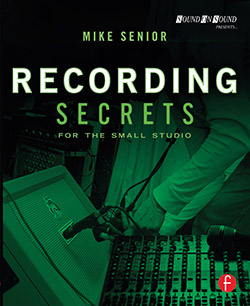Recording Secrets For The Small Studio - Additional Resources (1st Edition Archive)
Chapter 2: The Human Element
Table of Contents
(This page contains archived resources for the first edition of Recording Secrets For The Small Studio. You can access updated resource pages for the current edition here.)
Audio Files
(To download all WAV examples at once: 3MB ZIP)
Latency Tester File: Here’s an audio test file with a series of sharp signal transitions Ex02.01: WAV/MP3play_arrow that make it easy to measure latency using the loop-back methods mentioned in Section 2.1.6 of the book.
Section 2.3.2 Performance Parameters Demonstration: To clarify what I mean by some of the performance parameters listed in Section 2.3.2 of the book, take a listen to this rather uninspiring four-bar keyboard recording Ex02.02: WAV/MP3play_arrow. One problem is simply a question of balance: the repeated off-beat ‘B’ notes are consistently too loud compared with the more interesting upper and lower lines. This also affects the sense of pace, making the rhythm seem a bit stuck in the mud. In this example Ex02.03: WAV/MP3play_arrow, I’ve just adjusted the note balance to remedy these issues, in order to draw the listener’s ear towards the more musically important aspects of the line. I’ve also attempted to make the second, third, and fourth quarter notes into a mini-phrase by emphasising the middle note of each group. However, there’s no sense of phrasing across any of the bar lines, so in the final example Ex02.04: WAV/MP3play_arrow I’ve experimented with articulating longer two-bar phrase ‘arches’ using note durations.
Backing-track Stems For Overdubbing Practice: If you don’t have a project in progress suitable for the overdubbing Assignments in this (and later) chapters, then check out the ‘Recording Secrets’ Free Backing Stems Download Library for a range of projects in different styles, complete with accompanying session documentation.
Updates
- A-D/D-A Conversion Quality: Although I touch on dealing with recording mediums of different qualities on page 58 of the book, what I didn’t discuss was the issue of digital conversion quality. My views on this issue are very similar to my opinion about microphone preamps expressed on page 146
- only more so! In other words, I think that the differences between different analogue-to-digital converters are so small that even differences between microphone preamps are more significant, but that both are dwarfed by the differences between microphones and microphone placements. As such, I honestly find it difficult to recommend investing in expensive specialist A-D conversion boxes within almost any small-studio context on grounds of conversion quality. If you’d like to evaluate this assertion with your own ears, then check out 3D Audio’s range of comparison CDs, which feature wide-ranging shootouts of microphones, preamps, and A-D converters. This Sound On Sound comparison of three high-end digital-to-analogue converters also makes interesting reading within this context.
Links
Free Loop Download Libraries: If you want something a little more inspiring to play along to than a click track while overdubbing, check out the royalty-free samples available from Freesound, Looperman, and MusicRadar’s SampleRadar page. If they’re not at the right tempo, then the time-stretching options within Cockos Reaper

 provide a very affordable (and high quality) remedy.
provide a very affordable (and high quality) remedy.XLR-to-TRS Barrel Adaptors For Headphone Extension: As discussed in Section 2.1.1 of the book, you can make a robust headphone-extension cable by combining a TRS-to-XLR(male) cable with an XLR(female)-to-TRS barrel adaptor such as the Neumann NA3FJ. The cable can also be extended further by adding normal XLR mic cables in line.
Affordable Multi-output Headphone Amplifiers: You can get hold of extremely cheap models from companies such as ART, Behringer, and Samson, but personally I think it’s worth spending a bit more money on something a little more robust (such as the Aphex Headpod 4 which can deliver a bit more power to each output socket.
Oblique Strategies: Check out this detailed Oblique Strategies fan site for Brian Eno & Peter Schmidt’s classic Oblique Strategies card set, or just visit this online version of Oblique Strategies.
ASIO4ALL Universal Software ASIO Driver: Michael Tippach’s freeware ASIO4ALL
 driver lets you reduce monitoring latency dramatically in situations where you’re forced to work with a PC’s built-in audio hardware, rather than using a dedicated recording interface.
driver lets you reduce monitoring latency dramatically in situations where you’re forced to work with a PC’s built-in audio hardware, rather than using a dedicated recording interface.Latency Test Utility: To measure your PC system’s audio latency, try Oblique Audio’s freeware RTL Utility

 . Note, however, that they won’t take into account delays induced by plug-ins within a DAW project.
. Note, however, that they won’t take into account delays induced by plug-ins within a DAW project.
Further Reading
Working With Latency In Computer Systems: Here’s an excellent Sound On Sound magazine round-up of different monitoring schemes for computer DAW users: ‘Living With Latency’.
Glossaries Of Musical Terms: There’s now an extensive Wikipedia Musical Glossary, but check out MusicTheory.org.uk’s Glossary Of Italian Musical Terms if you want to hear audio examples of the Italian pronunciation.
A Brief Introduction To MIDI: Here are a few articles about the basics of MIDI, in case you fancy dipping your toe in the water there: Guitar Junky’s MIDI & Music Synthesis Tutorial and Sound On Sound magazine’s MIDI Basics series: Part 1, Part 2, Part 3, Part 4, and Part 5.

